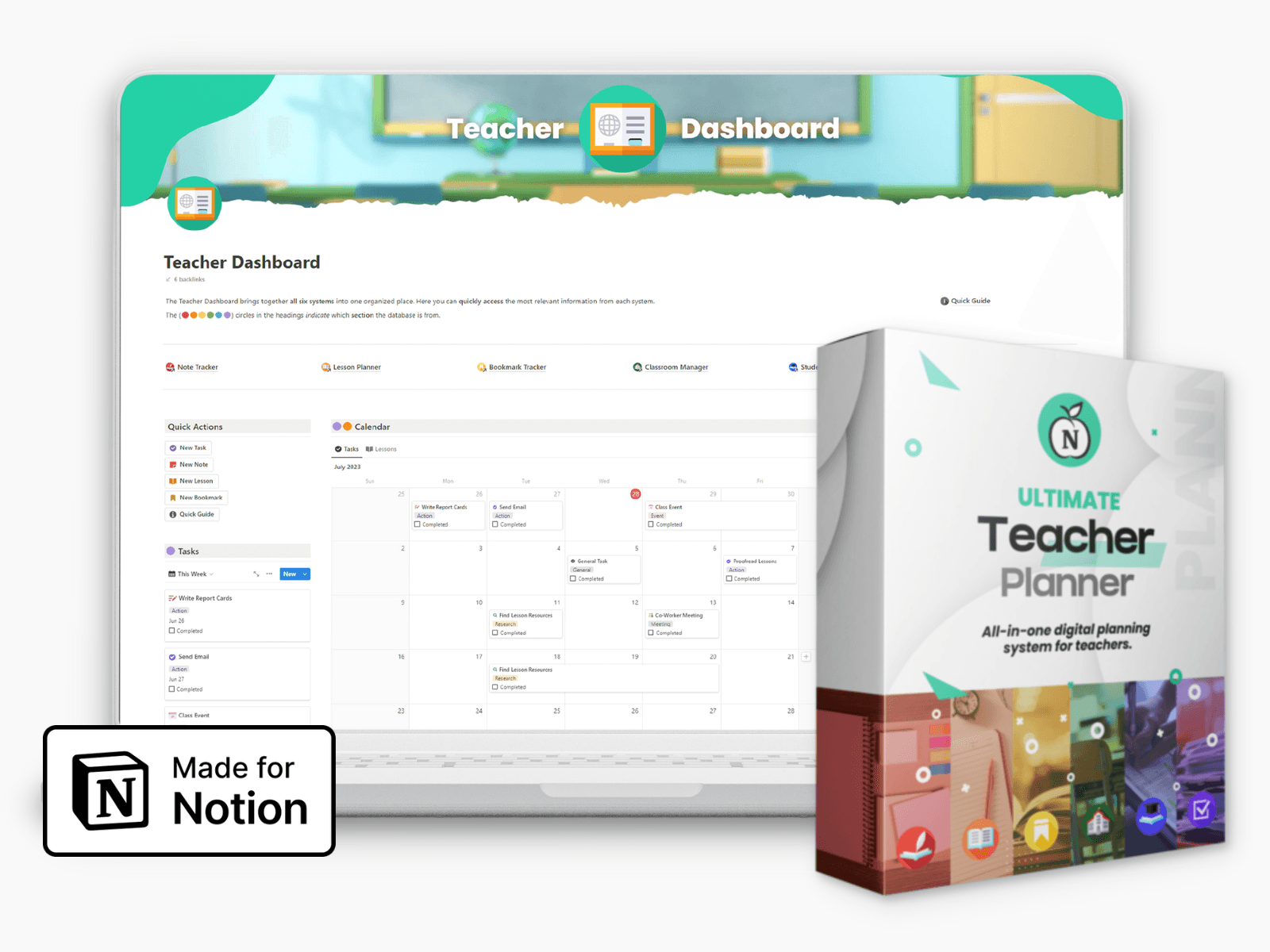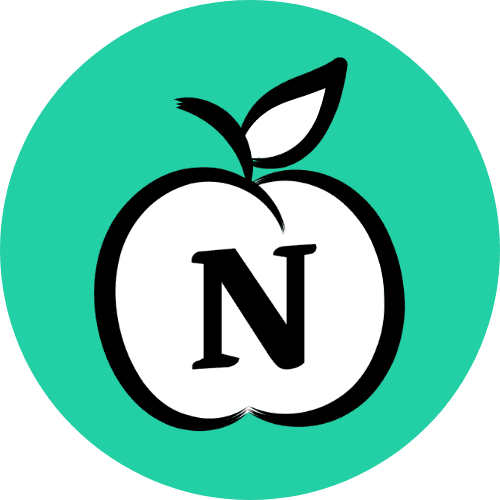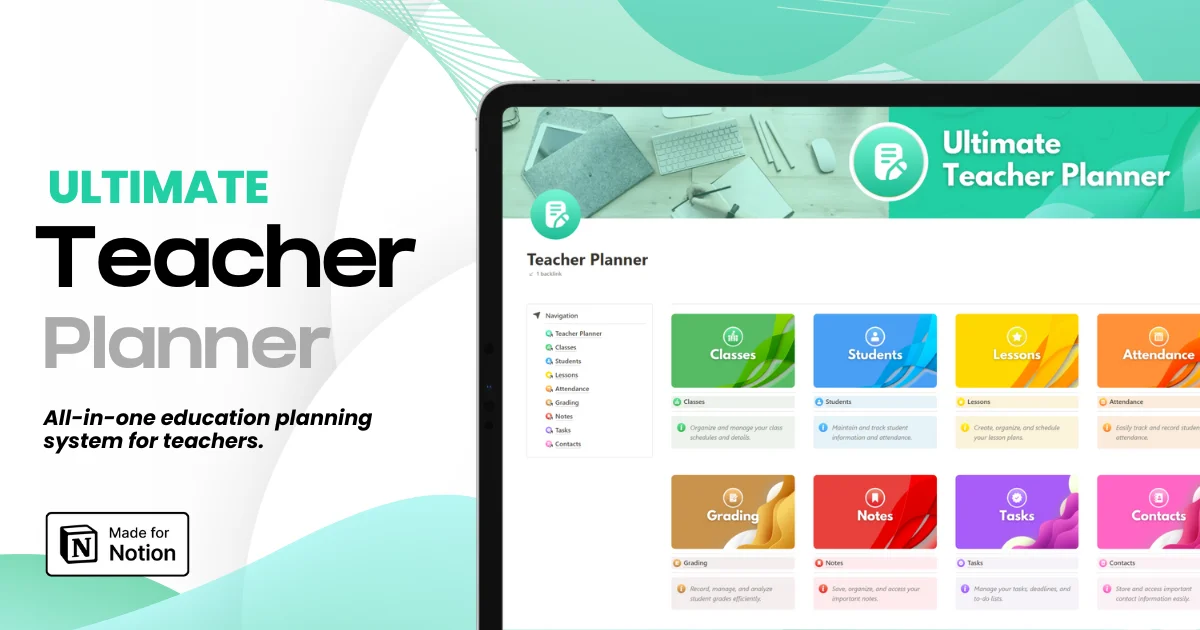

6 Little Hacks Teachers Rely on to Save Time in Class
6 Little Hacks Teachers Rely on to Save Time in Class
6 Little Hacks Teachers Rely on to Save Time in Class

Article by
Milo
ESL Content Coordinator & Educator
ESL Content Coordinator & Educator
All Posts
Ultimate Teacher Planner
The ultimate all-in-one education management system in Notion.
Learn More

Ultimate Teacher Planner
The ultimate all-in-one education management system in Notion.
Learn More

Ultimate Teacher Planner
The ultimate all-in-one education management system in Notion.
Learn More

You probably know that feeling when the bell rings, the students shuffle in, and you've barely had time to take a breath before the lesson is over.
Half the class is talking about homework while you're still setting up the projector, and after that, you have to explain the same thing for the third time because not all of them were listening to the first two. Now multiply that by 5 or 6 classes a day, and you've lost almost an hour of teaching time, and you don't even know it.
Teachers don't lack dedication; they lack time. Prep periods can be extended, and so can after-school hours.
But classes? Nope.
So if you want to see how to protect those precious minutes you have, read on.
How to Save Time and Not Lose the Impact
Time slips away fast in the classroom and, before you know it, there goes that dang bell again.
Here are some really great, really simple hacks that make all the difference when every second counts.
1. Use Pre-Made Video Explainers to Reinforce Key Points
Converting text to video has become one of the fastest ways for teachers to prep reusable materials, and it's one of the best hacks if you're trying to cut down hours of repeated effort. Instead of repeating the same thing 5 times a day, you just hit record once and then play it whenever you need it. You don't lose your voice, and you don't lose time.
The best part is that you can use the same video next year, too.
Students will like it because they'll be able to pause and watch again if they missed something, and you'll like it because it will make your job easier.
2. Use Digital Templates for Planning Lessons and Activities
If you start with a blank page, that will eat up a lot of time you don't have, but you can stop that problem before it even appears with templates. If you have a format ready to go, you'll save hours over the term. Lesson plan, quiz sheet, quick exit ticket, tests… The structure is already there; you swap out the details.
For example, you could set up a weekly planner in Notion and duplicate it every Monday.
3. Build Reusable Outlines for Lessons on Recurring Topics
Most teachers teach the same topic year after year, so it makes sense to write everything from scratch each year. It's much better to keep a master outline of those lessons, and when the unit comes around again, you tweak it if you need to.
Think of an English teacher who teaches Shakespeare every spring.
It'd be smart for them to keep a standing outline with notes on characters and discussions because it means less time spent on rewriting and more time with students.
4. Keep a Bank of Activities for 'Early Finishers'
Some students always finish early, and unless you're ready for that, the extra minutes you have will turn into wasted time.
One way to solve this is with a bank of ready-to-go activities. These can be puzzles, quick research prompts, extension questions, or even conversation topics. The last suggestion is particularly useful for students who are learning a new language.
When you have a folder of these on hand, you're never scrambling to keep early finishers busy, and the classroom stays calm while everyone works at their own pace.
5. Use Classroom Timers to Stay on Track
Some activities end up lasting longer than you planned, so it's good to have a timer on hand.
Put a countdown on the screen or use a small timer on your desk to keep track. Students will see how much time is left, and you won't have to keep reminding them. This way, transitions stay smooth and lessons don't drag on into oblivion.
A timer might be a small detail, but, believe it or not, it's one of the most effective ways to protect your schedule.
6. Record Routine Instructions Once and Use Them Over and Over
Some directions never change, so why repeat them dozens of times every year?
Record them once and you're done! Things like safety rules or project steps can all be explained in a quick clip, and the best part is, you're not the one explaining it. Just play the video when you need it and save your voice and energy.
This is especially handy for teachers who teach topics like science and have to keep going over safety guidelines at the start of every experiment.
Conclusion
Teaching is messy, and there's no hack to make it perfectly neat. But if you love teaching, you probably wouldn't even want it to be spick and span.
But! That doesn't mean you shouldn't make your job easier if there are ways to do so, and what do you know, there are!
You probably know that feeling when the bell rings, the students shuffle in, and you've barely had time to take a breath before the lesson is over.
Half the class is talking about homework while you're still setting up the projector, and after that, you have to explain the same thing for the third time because not all of them were listening to the first two. Now multiply that by 5 or 6 classes a day, and you've lost almost an hour of teaching time, and you don't even know it.
Teachers don't lack dedication; they lack time. Prep periods can be extended, and so can after-school hours.
But classes? Nope.
So if you want to see how to protect those precious minutes you have, read on.
How to Save Time and Not Lose the Impact
Time slips away fast in the classroom and, before you know it, there goes that dang bell again.
Here are some really great, really simple hacks that make all the difference when every second counts.
1. Use Pre-Made Video Explainers to Reinforce Key Points
Converting text to video has become one of the fastest ways for teachers to prep reusable materials, and it's one of the best hacks if you're trying to cut down hours of repeated effort. Instead of repeating the same thing 5 times a day, you just hit record once and then play it whenever you need it. You don't lose your voice, and you don't lose time.
The best part is that you can use the same video next year, too.
Students will like it because they'll be able to pause and watch again if they missed something, and you'll like it because it will make your job easier.
2. Use Digital Templates for Planning Lessons and Activities
If you start with a blank page, that will eat up a lot of time you don't have, but you can stop that problem before it even appears with templates. If you have a format ready to go, you'll save hours over the term. Lesson plan, quiz sheet, quick exit ticket, tests… The structure is already there; you swap out the details.
For example, you could set up a weekly planner in Notion and duplicate it every Monday.
3. Build Reusable Outlines for Lessons on Recurring Topics
Most teachers teach the same topic year after year, so it makes sense to write everything from scratch each year. It's much better to keep a master outline of those lessons, and when the unit comes around again, you tweak it if you need to.
Think of an English teacher who teaches Shakespeare every spring.
It'd be smart for them to keep a standing outline with notes on characters and discussions because it means less time spent on rewriting and more time with students.
4. Keep a Bank of Activities for 'Early Finishers'
Some students always finish early, and unless you're ready for that, the extra minutes you have will turn into wasted time.
One way to solve this is with a bank of ready-to-go activities. These can be puzzles, quick research prompts, extension questions, or even conversation topics. The last suggestion is particularly useful for students who are learning a new language.
When you have a folder of these on hand, you're never scrambling to keep early finishers busy, and the classroom stays calm while everyone works at their own pace.
5. Use Classroom Timers to Stay on Track
Some activities end up lasting longer than you planned, so it's good to have a timer on hand.
Put a countdown on the screen or use a small timer on your desk to keep track. Students will see how much time is left, and you won't have to keep reminding them. This way, transitions stay smooth and lessons don't drag on into oblivion.
A timer might be a small detail, but, believe it or not, it's one of the most effective ways to protect your schedule.
6. Record Routine Instructions Once and Use Them Over and Over
Some directions never change, so why repeat them dozens of times every year?
Record them once and you're done! Things like safety rules or project steps can all be explained in a quick clip, and the best part is, you're not the one explaining it. Just play the video when you need it and save your voice and energy.
This is especially handy for teachers who teach topics like science and have to keep going over safety guidelines at the start of every experiment.
Conclusion
Teaching is messy, and there's no hack to make it perfectly neat. But if you love teaching, you probably wouldn't even want it to be spick and span.
But! That doesn't mean you shouldn't make your job easier if there are ways to do so, and what do you know, there are!
Ultimate Teacher Planner
The ultimate all-in-one education management system in Notion.
Learn More

Ultimate Teacher Planner
The ultimate all-in-one education management system in Notion.
Learn More

Ultimate Teacher Planner
The ultimate all-in-one education management system in Notion.
Learn More

2025 Notion4Teachers. All Rights Reserved.
2025 Notion4Teachers. All Rights Reserved.
2025 Notion4Teachers. All Rights Reserved.
2025 Notion4Teachers. All Rights Reserved.








